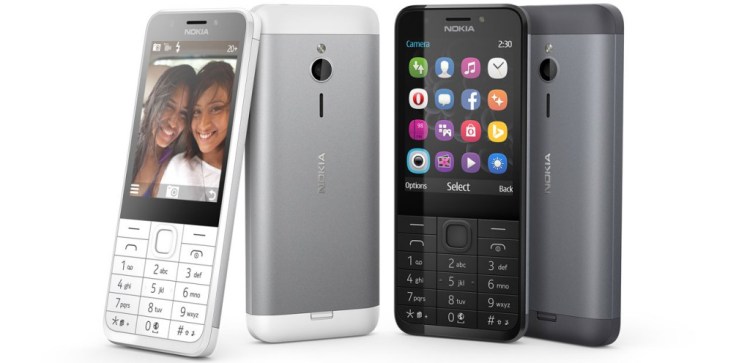Microsoft has launched a new Nokia-branded handset today — the Nokia 230 feature phone, which is pitched as “perfect for taking and sharing selfies.”
The device, which also comes in a dual-SIM variant, runs on the Nokia Series 30+ operating system, sports a 2.8″ screen, an FM radio (naturally), memory card support (up to 32GB), and 2-megapixel front- and rear-shooters. That may not seem like a particularly impressive camera if you’re used to smartphones, but it’s not too shabby for a feature phone at that price — many only have VGA cameras.
It’s worth noting here that the Nokia 230 has a touchscreen and physical buttons, which may be an appealing proposition for some. Both versions of the device will cost $55, and go on sale first in Asia and the Middle East from December, followed by “other markets” next year.
If the “Nokia 230” sounds familiar, well, you may be thinking of the Nokia Asha 230 which was announced in early 2014. Hopefully, this shouldn’t cause too much confusion, as the phones are completely different in style (although they both have the same screen size).
Featured price
While smartphones are the order of the day in most Western regions, feature phones remain popular in many developing markets, partly due to their affordability. Indeed, back in January, Microsoft launched the Nokia 215 feature phone which — at $29 — was touted as its cheapest Internet device yet.
However, smartphones have been coming down in price, too. Shortly after the Nokia 215, Microsoft introduced the Lumia 435 and Lumia 532 smartphones, which cost $80 and $90, respectively.
But feature phones are more than just an affordable entry point into the market. Anyone seeking a spare phone with a long battery life — perhaps if they’re traveling somewhere without electricity — may find feature phones useful, as they offer significantly longer talk- and standby-time.
For example, both versions of the Nokia 230 promise a pretty impressive 23 hours of talk-time — more than the Nokia 215. The single-SIM incarnation is pitched at 27 days of standby-time, 2 days shy of the Nokia 215, and 22 days for the dual-SIM variant. Still, that’s pretty long battery life in anyone’s eyes.
While the Nokia mobile brand is more or less dead in most Western countries, it’s clear that Microsoft continues to see value in bringing a series of affordable low-end phones to market. Things could get confusing, however, when Nokia itself eventually returns to making mobile phones, after offloading its devices division to Microsoft a little over a year ago
Meanwhile, check out the official promo video for the new Nokia 230 here.
https://www.youtube.com/watch?v=GrZs6hJ-1b4



